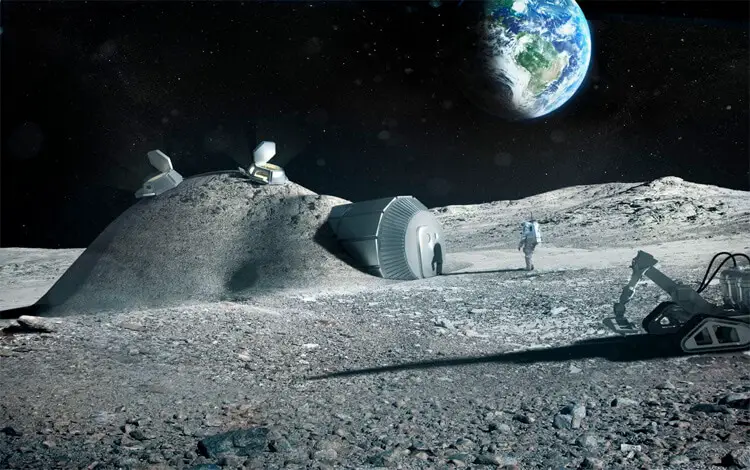Recent notification that water might be present at the lunar poles has sparked interest in the Moon again. Moon colonies could also avoid the problem of long lunar nights which are about 354 hours=a little more than two weeks. They would take advantage of the sun continuously, at least during the summer. There is no data for the winter yet.
Permanent people living on a planet other than Earth is one of science fiction's favorite themes. As technology has advanced and concerns about the future of humanity on Earth have increased, the argument that space colonization is something earth is starting to be believed. Because of how close it is to Earth, the Moon has been seen as the best expansion after Earth.
Today's moon colony looks like the plans of the past but with the technology of the future. The European Space Agency announced plans to build a moon colony using 3-D printers. Above is a picture of their plans.
Using a mixture of silicon, calcium, iron, aluminum, and magnesium oxide to simulate the composition of moon dust, the agency showed off their theory by printing a honeycomb wall from the mixture. Once on the moon, they can create big frames that use the moon's own defenses to protect people from gamma radiation and micro-meteorites and to make it cost less.
I believe that this relates to settling James town and Plymouth. I think this because they both faced many hardships. You would not believe that some of the problems were much related. They both faced the issue of trying to start something new. One of the similar problems they had was being able to get food and water at will. Another is they struggled at building homes/shelters in there lands.
Recent notification that water might be present at the lunar poles has sparked interest in the Moon again. Moon colonies could also avoid the problem of long lunar nights which are about 354 hours=a little more than two weeks. They would take advantage of the sun continuously, at least during the summer. There is no data for the winter yet.
Permanent people living on a planet other than Earth is one of science fiction's favorite themes. As technology has advanced and concerns about the future of humanity on Earth have increased, the argument that space colonization is something earth is starting to be believed. Because of how close it is to Earth, the Moon has been seen as the best expansion after Earth.
Today's moon colony looks like the plans of the past but with the technology of the future. The European Space Agency announced plans to build a moon colony using 3-D printers. Above is a picture of their plans.
Using a mixture of silicon, calcium, iron, aluminum, and magnesium oxide to simulate the composition of moon dust, the agency showed off their theory by printing a honeycomb wall from the mixture. Once on the moon, they can create big frames that use the moon's own defenses to protect people from gamma radiation and micro-meteorites and to make it cost less.
I believe that this relates to settling James town and Plymouth. I think this because they both faced many hardships. You would not believe that some of the problems were much related. They both faced the issue of trying to start something new. One of the similar problems they had was being able to get food and water at will. Another is they struggled at building homes/shelters in there lands.
http://www.hq.nasa.gov/office/



Hi Nick, Great job writing this post. Your blog was really interesting and you did a good job connecting it to the curriculum. What I really liked was the facts that you shared. You said that there is a plan to build a moon colony using 3-D printers and you included pictures. That really caught my attention. I could also connect the hardships of the astronauts to Jamestown and the voyage over to the New World. Overall I thought you did a good job.
ReplyDeleteI love how you chose a topic that most people wouldn't think of relating to Jamestown, but you did. Very creative and interesting! Great job!
ReplyDelete